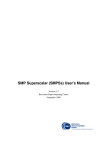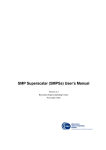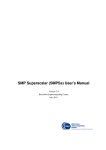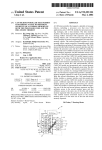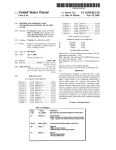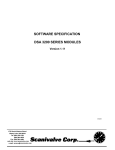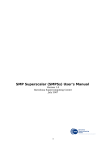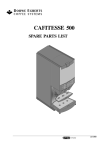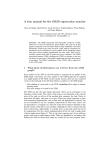Download Cell Superscalar (CellSs) User`s Manual
Transcript
Cell Superscalar (CellSs) User’s Manual
Version 2.2
Barcelona Supercomputing Center
May 2009
i
Cell Superscalar User’s Manual
Contents
1
Introduction
1
2
Installation
2.1 Compilation requirements
2.2 Compilation . . . . . . . .
2.3 Runtime requirements . . .
2.4 User environment . . . . .
.
.
.
.
1
1
2
3
3
.
.
.
.
.
.
.
.
.
.
.
4
4
4
4
6
6
7
8
8
9
10
11
4
Compiling
4.1 Usage . . . . . . . . . . . . . . . . . . . . . . . . . . . . . . . . . . . . . . . . . .
4.2 Examples . . . . . . . . . . . . . . . . . . . . . . . . . . . . . . . . . . . . . . . .
12
13
14
5
Setting the environment and executing
5.1 Setting the number of SPUs and executing . . . . . . . . . . . . . . . . . . . . . . .
15
15
6
Programming examples
6.1 Matrix mutlitply . . . . . . . . . . . . . . . . . . . . . . . . . . . . . . . . . . . . .
16
16
7
CellSs internals
18
8
Advanced features
8.1 Using paraver . . . . . . . . . . . . . . . . . . . . . . . . . . . . . . . . . . . . . .
8.2 Configuration file . . . . . . . . . . . . . . . . . . . . . . . . . . . . . . . . . . . .
20
20
22
9
CellSs SPU memory functionality
9.1 Dynamic memory allocation . . . . . . . . . . . . . . . . . . . . . . . . . . . . . .
9.2 DMA accesses . . . . . . . . . . . . . . . . . . . . . . . . . . . . . . . . . . . . .
9.3 Strided Memory Access . . . . . . . . . . . . . . . . . . . . . . . . . . . . . . . . .
23
23
23
25
3
.
.
.
.
.
.
.
.
.
.
.
.
.
.
.
.
.
.
.
.
Programming with CellSs
3.1 C Programming . . . . . . . . . . .
3.1.1 Task selection . . . . . . . .
3.1.2 Specifying a task . . . . . .
3.1.3 Scheduling a task . . . . . .
3.1.4 Waiting on data . . . . . . .
3.1.5 Mixed SPU and PPU code .
3.2 Fortran Programming . . . . . . . .
3.2.1 Task selection . . . . . . . .
3.2.2 Specifying a task . . . . . .
3.2.3 Waiting on data . . . . . . .
3.2.4 Fortran compiler restrictions
References
.
.
.
.
.
.
.
.
.
.
.
.
.
.
.
.
.
.
.
.
.
.
.
.
.
.
.
.
.
.
.
.
.
.
.
.
.
.
.
.
.
.
.
.
.
.
.
.
.
.
.
.
.
.
.
.
.
.
.
.
.
.
.
.
.
.
.
.
.
.
.
.
.
.
.
.
.
.
.
.
.
.
.
.
.
.
.
.
.
.
.
.
.
.
.
.
.
.
.
.
.
.
.
.
.
.
.
.
.
.
.
.
.
.
.
.
.
.
.
.
.
.
.
.
.
.
.
.
.
.
.
.
.
.
.
.
.
.
.
.
.
.
.
.
.
.
.
.
.
.
.
.
.
.
.
.
.
.
.
.
.
.
.
.
.
.
.
.
.
.
.
.
.
.
.
.
.
.
.
.
.
.
.
.
.
.
.
.
.
.
.
.
.
.
.
.
.
.
.
.
.
.
.
.
.
.
.
.
.
.
.
.
.
.
.
.
.
.
.
.
.
.
.
.
.
.
.
.
.
.
.
.
.
.
.
.
.
.
.
.
.
.
.
.
.
.
.
.
.
.
.
.
.
.
.
.
.
.
.
.
.
.
.
.
.
.
.
.
.
.
.
.
.
.
.
.
.
.
.
.
.
.
.
.
.
.
.
.
.
.
.
.
.
.
.
.
.
.
.
.
.
.
.
.
.
.
.
.
.
.
.
.
.
.
.
.
.
.
.
.
.
.
.
.
.
.
.
.
.
.
.
.
.
.
.
.
.
.
.
.
.
.
.
.
.
.
.
.
.
.
.
.
.
.
.
.
.
.
.
.
.
.
.
.
.
.
.
.
.
.
.
.
.
.
.
27
ii
Barcelona Supercomputing Center
List of Figures
1
2
3
CellSs runtime behavior . . . . . . . . . . . . . . . . . . . . . . . . . . . . . . . .
One dimensional memory access pattern. . . . . . . . . . . . . . . . . . . . . . . .
Two dimensional memory access pattern. . . . . . . . . . . . . . . . . . . . . . . .
19
25
26
Cell Superscalar User’s Manual
1
1
Introduction
The Cell Broadband Engine (Cell/BE) is an heterogeneous multi-core architecture with nine cores.
The first generation of the Cell BE includes a 64-bit multi-threaded PowerPC processor element (PPE)
and eight synergistic processor elements (SPEs), connected by an internal high bandwidth Element
Interconnect Bus (EIB). The PPE has two levels of on-chip cache and also supports IBMs VMX to
accelerate multimedia applications by using VMX SIMD units.
This document is the user manual of the Cell Superscalar (CellSs) framework, which is based on a
source-to-source compiler and a runtime library. The programming model allows programmers to
write sequential applications and the framework is able to exploit the existing concurrency and to use
the different components of the Cell/BE (PPE and SPEs) by means of an automatic parallelization at
execution time. The requirements we place on the programmer are that the application is composed
of coarse grain functions (for example, by applying blocking) and that these functions do not have
collateral effects (only local variables and parameters are accessed). These functions are identified
by annotations (somehow similar to the OpenMP ones), and the runtime will try to parallelize the
execution of the annotated functions (also called tasks).
The source-to-source compiler separates the annotated functions from the main code and the library
provides a manager program to be run in the SPEs that is able to call the annotated code. However,
an annotation before a function does not indicate that this is a parallel region (as it does in OpenMP).
To be able to exploit the parallelism, the CellSs runtime builds a data dependency graph where each
node represents an instance of an annotated function and edges between nodes denote data dependencies. From this graph, the runtime is able to schedule for execution independent nodes to different
SPEs at the same time. All data transfers required for the computations in the SPEs are automatically performed by the runtime. Techniques imported from the computer architecture area like the
data dependency analysis, data renaming and data locality exploitation are applied to increase the
performance of the application.
While OpenMP explicitly specifies what is parallel and what is not, with CellSs what is specified
are functions whose invocations could be run in parallel, depending on the data dependencies. The
runtime will find the data dependencies and will determine, based on them, which functions can be run
in parallel with others and which not. Therefore, CellSs provides programmers with a more flexible
programming model with an adaptive parallelism level depending on the application input data and
the number of available cores.
2
Installation
Cell Superscalar is distributed in source code form and must be compiled and installed before using it. The runtime library source code is distributed under the LGPL license and the rest of the
code is distributed under the GPL license. It can be downloaded from the CellSs web page at
http://www.bsc.es/cellsuperscalar .
2.1
Compilation requirements
The CellSs compilation process requires the following system components:
2
Barcelona Supercomputing Center
• GCC 4.1 or later.
• GNU make
• SPE Runtime Management Library, version 2.0 or higher.
• IBM XL Fortran multicore acceleration for Linux on System p. V11.11 . This is only necessary
when CellSs Fortran support is required.
Additionally, if you change the source code you may require:
• automake
• autoconf ≥ 2.60
• libtool
• rofi-bison2
• GNU flex
2.2
Compilation
To compile and install CellSs please follow the following steps:
1. Decompress the source tarball.
tar -xvzf CellSS-2.2.tar.gz
2. Enter into the source directory.
cd CellSS-2.2
3. If necessary, check that you have set the PATH and LD LIBRARY PATH environment variables
to point to the CBE SDK installation.
4. Run the configure script, specifying the installation directory as the prefix argument. The configure script also accepts the following optional parameters:
• --with-cellsdk=prefix Specifies the CBE SDK installation path.
More information can be obtained by running ./configure --help.
./configure --prefix=/opt/CellSS
There are also some environment variables that affect the configuration behaviour.
• PPU C compiler may be specified with the PPUCC variable.
• PPU C compiler flags may be given with the PPUCFLAGS variable.
1
2
See http://www.alphaworks.ibm.com/tech/cellfortran
Available at http://www.bsc.es/plantillaH.php?cat id=351
Cell Superscalar User’s Manual
3
• PPU C++ compiler may be specified with the PPUCXX variable.
• PPU C++ compiler flags may be given with the PPUCXXFLAGS variable.
• PPU Fortran compiler may be specified with the PPUFC variable.
• PPU Fortran compiler flags may be given with PPUFCFLAGS.
Note that currently our libraries only support 32 bits. If you choose to change any of the PPU
compilers, then you must also pass the proper flag to force a 32 bits target. One simple way to
do it is to force it into the command. For instance:
export PPUCC="/opt/sdk3.0/bin/ppu-gcc -m32"
• SPU C compiler may be specified with the SPUCC variable.
• SPU C compiler flags may be given with the SPUCFLAGS variable.
• SPU C++ compiler may be specified with the SPUCXX variable.
• SPU C++ compiler flags may be given with the SPUCXXFLAGS variable.
• SPU Fortran compiler may be specified with the SPUFC variable.
• SPU Fortran compiler flags may be given with SPUFCFLAGS.
5. Run make.
make
6. Run make install.
make install
2.3
Runtime requirements
The CellSs runtime requires the following system components:
• CBE SDK 3.0 or newer
2.4
User environment
If the CBE SDK resides on a non standard directory, then the user must set the LD LIBRARY PATH
and PATH accordingly.
If CellSs has not been installed into a system directory, then the user must set the following environment variables:
1. The PATH environment variable must contain the bin subdirectory of the installation.
export PATH=$PATH:/opt/CellSS/bin
2. The LD LIBRARY PATH environment variable must contain the lib subdirectory from the installation.
export LD_LIBRARY_PATH=$LD_LIBRARY_PATH:/opt/CellSS/lib
4
3
Barcelona Supercomputing Center
Programming with CellSs
CellSs applications are based on the parallelization at task level of sequential applications. The tasks
(functions or subroutines) selected by the programmer will be executed in the SPE processors. Furthermore, the runtime detects when tasks are data independent between them and is able to schedule
the simultaneous execution of several of them on different SPEs. Since, the SPE cannot access the
main memory, the data required for the computation in the SPE is transferred by DMA. All the above
mentioned actions (data dependency analysis, scheduling and data transfer) are performed transparently to the programmer. However, to take benefit of this automation, the computations to be executed
in the Cell BE should be of certain granularity (about 50µs). A limitation on the tasks is that they can
only access their parameters and local variables. In case global variables are accessed the compilation
will fail.
3.1
C Programming
The C version of CellSs borrows the syntax from OpenMP in the way that the code is annotated using
special preprocessor directives. Therefore, the same general syntax rules apply; that is, directives are
one line long but they can span into multiple lines by escaping the line ending.
3.1.1
Task selection
In CellSs, it is a responsibility of the application programmer to select tasks of certain granularity.
For example, blocking is a technique that can be applied to increase the granularity of the tasks in
applications that operate on matrices. Below there is a sample code for a block matrix multiplication:
void block_addmultiply (double C[BS][BS], double A[BS][BS],
double B[BS][BS])
{
int i, j, k;
for (i=0; i < BS; i++)
for (j=0; j < BS; j++)
for (k=0; k < BS; k++)
C[i][j] += A[i][k] * B[k][j];
}
3.1.2
Specifying a task
A task is conceived in the form of a procedure, i.e. a function without return value. Then, a procedure
is “converted” into a CellSs task by providing a simple annotation before its declaration or definition:
#pragma css task [input(<input parameters>)]optional \
[inout(<inout parameters>)]optional \
Cell Superscalar User’s Manual
5
[output(<output parameters>)]optional \
[highpriority]optional
<function declaration or definition>
Where each clause serves the following purposes:
• input clause lists parameters whose input value will be read.
• inout clause lists parameters that will be read and written by the task.
• output clause lists parameters that will be written to.
• highpriority clause specifies that the task will be scheduled for execution earlier than tasks
without this clause.
The parameters listed in the input, inout and output clauses are separated by commas. Only the
parameter name and dimension(s) need to be specified, not the type. Although the dimensions must
be omitted if present in the parameter declaration.
Remember that, when invoking a task, the issued parameters must must be aligned on a 4-byte boundary. Not fulfilling this requirement may produce DMA transfer errors or unexpected situations at the
SPE.
Examples
In this example, the “factorial” task has a single input parameter “n” and a single output parameter
“result”.
#pragma css task input(n) output(result)
void factorial (unsigned int n, unsigned int *result)
{
*result = 1;
for (; n > 1; n--)
*result = *result * n;
}
The next example, has two input vectors “left”, of size “leftSize”, and “right”, of size “rightSize”; and
a single output “result” of size “leftSize+rightSize”.
#pragma css task input(leftSize, rightSize) \
input(left[leftSize], right[rightSize]) \
output(result[leftSize+rightSize])
void merge (float *left, unsigned int leftSize,
float *right, unsigned int rightSize, float *result)
{
...
}
6
Barcelona Supercomputing Center
The next example shows another feature. In this case, with the keyword highpriority the user
is giving hints to the scheduler: the jacobi tasks will be, when data dependencies allow it, executed
before the ones that are not marked as high-priority.
#pragma css task input(lefthalo[32], tophalo[32], righthalo[32], \
bottomhalo[32]) inout(A[32][32]) highpriority
void jacobi (float *lefthalo, float *tophalo,
float *righthalo, float *bottomhalo, float *A)
{
...
}
3.1.3
Scheduling a task
Once all the tasks have been specified, the next step is to use them. The way to do it is as simple as
it gets: just call the annotated function normally. However, there still exists a small requirement, in
order to have the tasks scheduled by the CellSs runtime, the annotated functions must be invoked in a
block surrounded by these two directives:
#pragma css start
#pragma css finish
These two directives can only be used once in a program, i.e. it is not possible to annotate a start
directive after3 a finish directive has been annotated. They are also mandatory and must enclose
all annotated function invocations.
Beware of the fact that the compiler will not detect these issues; the runtime will complain in some
cases but may also incur into unexpected behaviour. Section 3.1.4 provides some simple examples.
3.1.4
Waiting on data
When code outside the tasks needs to handle data manipulated also by code inside the tasks, the
automatic dependency tracking performed by the runtime is not enough to ensure correct read and
write order. To solve this, CellSs offers some synchronization directives.
As in OpenMP, there is a barrier directive:
#pragma css barrier
This forces the main thread to wait for the completion of all generated tasks so far. However, this kind
of synchronization is too coarse grained and in many cases can be counter productive. To achieve a
finer grained control over data readiness, the wait on directive is also available:
3
After in the code execution path.
Cell Superscalar User’s Manual
7
#pragma css wait on(<list of variables>)
In this case, the main thread waits (or starts running tasks) until all the values of the listed variables
have been committed. Like in other clauses4 , multiple variable names are separated by commas.
The data unit to be waited on should be consistent with the data unit of the task. For example, if the
task is operating on the full range of an array, we cannot wait on a single element arr[i] but on its
base address arr.
Examples
The next example shows how a wait on directive can be used:
#pragma css task inout(data[size]) input(size)
void bubblesort (float *data, unsigned int size)
{
...
}
void main ()
{
...
#pragma css start
bubblesort(data, size);
#pragma css wait on(data)
for (unsigned int i = 0; i < size; i++)
printf("%f ", data[i]);
#pragma css finish
}
In this particular case, a barrier could have served for the same purpose since there is just one output
variable.
3.1.5
Mixed SPU and PPU code
The CellSs programming model allows by design to mix SPU and PPU code in the same source file.
Tasks are always compiled for the SPU architecture. Functions reachable by tasks are also on the SPU
side. All other functions are on the PPU side by default, including those reachable by them. These
heuristics can lead to some functions appearing on both sides.
4
Clauses that belong to the task directive.
8
Barcelona Supercomputing Center
However, the architecture selection heuristics are only applied individually to each source file. This
could lead to some functions being compiled for the wrong architecture and producing linking errors.
For instance, a function in one source file could be called by a task in another source file. Unless that
function is also called by a task from the same source file, it will not be compiled for the SPU side.
To solve this problem, the architecture selection heuristics can be skipped by specifying explicitly the
target architecture. Function definitions and declarations can have their target architecture(s) specified
by using the following construct:
#pragma css target [spu]optional [ppu]optional
<function declaration or definition>
Functions can have either target or both simultaneously.
3.2
Fortran Programming
As in C, the Fortran version of CellSs also is based on the syntax of OpenMP for Fortran-95. This
version of CellSs only supports free form code and needs some Fortran-95 standard features.
3.2.1
Task selection
In CellSs it is responsibility of the application programmer to select tasks of a certain granularity. For
example, blocking is a technique that can be applied to increase such granularity in applications that
operate on matrices. Below there is a sample code for a block matrix multiplication:
subroutine block_addmultiply(C, A, B, BS)
implicit none
integer, intent(in) :: BS
real, intent(in) :: A(BS,BS), B(BS,BS)
real, intent(inout) :: C(BS,BS)
integer :: i, j, k
do i=1, BS
do j=1, BS
do k=1, BS
C(i,j) = C(i,j) + A(i,k)*B(k,j)
enddo
enddo
enddo
end subroutine
Cell Superscalar User’s Manual
3.2.2
9
Specifying a task
A task is conceived in the form of a subroutine. The main difference with C CellSs annotations is that,
in Fortran, the language provides the means to specify the direction of the arguments in a procedure.
Moreover, while arrays in C can be passed as pointers, Fortran does not encourage that practice. In
this sense, annotations in Fortran are simpler than in C. The annotations have the form of a Fortran-95
comment followed by a “$” and the framework sentinel keyword (CSS in this case). This is the same
syntax that OpenMP uses in Fortran-95.
In Fortran, each subprogram calling tasks must know the interface for those tasks. For this purpose,
the programmer must specify the task interface in the caller subprograms and also write some CellSs
annotations to let the compiler know that there is a task. The following requirements must be satisfied
by all Fotran tasks in CellSs:
• The task interface must specify the parameter directions of all parameters. That is, by using
INTENT (<direction>); where <direction> is one of: IN, INOUT or OUT.
• Provide an explicit shape for all array parameters in the task (caller subprogram).
• Provide a !$CSS TASK annotation for the caller subprogram with the task interface.
• Provide a !$CSS TASK annotation for the task subroutine.
The following example shows how a subprogram calling a CellSs task looks in Fortran. Note that it
is not necessary to specify the parameter directions in the task subroutine, they are only necessary in
the interface.
subroutine example()
...
interface
!$CSS TASK
subroutine block_add_multiply(C, A, B, BS)
! This is the task interface. Specifies the size and
! direction of the parameters.
implicit none
integer, intent(in) :: BS
real, intent(in) :: A(BS,BS), B(BS,BS)
real, intent(inout) :: C(BS,BS)
end subroutine
end interface
...
!$CSS START
...
call block_add_multiply(C, A, B, BLOCK_SIZE)
...
!$CSS FINISH
...
10
Barcelona Supercomputing Center
end subroutine
!$CSS TASK
subroutine block_add_multiply(C, A, B, BS)
! Here goes the body of the task (the block multiply_add
! in this case)
...
end subroutine
It is also necessary, as the example shows, to call the tasks between START and FINISH annotation
directives. These are executable statements that must be after the declarations, in the executable part
of the subprogram. START and FINISH statements must only be executed once in the application.
Example
The following example shows part of a CellSs application using another feature. The HIGHPRIORITY
clause is used to indicate that one task is high priority and must be executed before non-high priority
tasks as soon as its data dependencies allow.
interface
!$CSS TASK HIGHPRIORITY
subroutine jacobi(lefthalo, tophalo, righthalo, bottomhalo, A)
real, intent(in), dimension(32) :: lefthalo, tophalo, &
righthalo, bottomhalo
real, intent(inout) :: A(32,32)
end subroutine
end interface
3.2.3
Waiting on data
CellSs provides two different ways of waiting on data. These features are useful when the user wants
to read the results of some tasks in the main thread. By default tasks will write their results back to
main memory after its execution. Nevertheless, the main thread does not know when these results are
ready. With BARRIER and WAIT ON, the main program stops its execution until the data is available.
BARRIER is the most conservative option. When the main thread reaches a barrier, waits until all
tasks have finished and have written their results back to main memory. The syntax is simple:
...
do i=1, N
call task_a(C(i),B)
enddo
...
!$CSS BARRIER
Cell Superscalar User’s Manual
11
print *, C(1)
...
The other way is to specify exactly which variables we want the program to wait to be available before
the execution goes on.
!$CSS WAIT ON(<list of variables>)
Where the list of variables is a comma separated list of variable names whose values must have been
computed before continuing the execution.
Example
!$CSS TASK
subroutine bubblesort (data, size)
integer, intent(in) :: size
real, intent(inout) :: data(size)
...
end subroutine
program main
...
interface
!$CSS TASK
subroutine bubblesort (data, size)
integer, intent(in) :: size
real, intent(inout) :: data(size)
end subroutine
end interface
...
call bubblesort(data, size);
!$CSS WAIT ON(data)
do i=1, size
print *, data(i)
enddo
end
3.2.4
Fortran compiler restrictions
This is the first release of CellSs with a Fortran compiler and it has some limitations. Some will disappear in the future. They consist of compiler specific and non-standard features. Also deprecated forms
in the Fortran-95 standard are not supported and are not planned to be included in future releases.
12
Barcelona Supercomputing Center
• Case sensitiveness: The CellSs Fortran compiler is case insensitive. However, task names must
be written in lowercase.
• It is not allowed to mix generic interfaces with tasks.
• Internal subprograms cannot be tasks.
• Use of modules within tasks has not been tested in this version.
• Optional and named parameters are not allowed in tasks.
• Some non-standard common extensions like Value parameter passing are not supported or have
not been tested yet. In further releases of CellSs we expect to support a subset of the most
common extensions.
• Only explicit shape arrays and scalars are supported as task parameters.
• The MULTOP parameter is not supported.
• Tasks cannot have an ENTRY statement.
• Array subscripts cannot be used as task parameters.
• PARAMETER arrays cannot be used as task parameters.
4
Compiling
The CellSs compiler infastructure is composed of a C99 source-to-source compiler, a Fortran-95
source-to-source compiler and a common driver.
The driver is called cellss-cc and depending on each source filename suffix invokes transparently
the C compiler or the Fortran-95 compiler. C files must have the “.c” suffix. Fortran files can have
either the “.f”, “.for”, “.f77”, “.f90”, or “.f95” suffix, they can also be in uppercase in case
preprocessing is desired.
The cellss-cc driver behaves similarly to a native compiler. It can compile individual files one at
a time, several ones, link several objects into an executable or perform all operations in a single step.
The compilation process consists in processing the CellSs pragmas, transforming the code according
to those, compiling both for the PPU and SPU with the corresponding compilers (ppu-c99 and
spu-c99 for C programs and, in the case of Fortran programs, with ppuxlf95 and spuxlf), and
packing both objects and additional information required for linking into a single object..
The linking process consists in unpacking the object files, generating additional code required for the
SPU part, compiling it, linking all SPU objects together, embedding the SPU executable into a PPU
object (ppu32-embedspu), generating additional code required for the PPU part , compiling it, and
finally linking all PPU objects together with the CellSs runtime to generate the final executable.
13
Cell Superscalar User’s Manual
4.1
Usage
The cellss-cc compiler has been designed to mimic the options and behaviour of common C compilers. However, it uses two other compilers internally that may require different sets of compilation
options.
To cope with this distinction, there are general options and target specific options. While the general
options are applied to PPU code and SPU code, the target specific options allow to specify options to
pass to the PPU compiler and the SPU compiler independently.
The list of supported options is the following:
> cellss-cc -help
Usage: cellss-cc <options and sources>
Options:
-D<macro>
-D<macro>=<value>
-g
-h|--help
-I<directory>
-k|--keep
-l<library>
-L<directory>
-O<level>
-o <filename>
-c
-t|--tracing
-v|--verbose
Defines ’macro’ with value ’1’ in the
preprocessor.
Defines ’macro’ with value ’value’ in the
preprocessor.
Enables debugging.
Shows usage help.
Adds ’directory’ the list of preprocessor
search paths.
Keeps intermediate source and object files.
Links with the specified library.
Adds ’directory’ the list of library search
paths.
Enables optimization level ’level’.
Sets the name of the output file.
Specifies that the code must only be compiled
(and not linked).
Enables run time tracing.
Enables verbose operation.
PPU specific options:
-WPPUp,<options>
Passes the comma separated
the PPU C preprocessor.
-WPPUc,<options>
Passes the comma separated
the PPU C compiler.
-WPPUf,<options>
Passes the comma separated
the PPU Fortran compiler.
-WPPUl,<options>
Passes the comma separated
the PPU linker.
SPU specific options:
list of options to
list of options to
list of options to
list of options to
14
Barcelona Supercomputing Center
-WSPUp,<options>
-WSPUc,<options>
-WSPUf,<options>
-WSPUl,<options>
4.2
Passes the comma separated
the SPU C preprocessor.
Passes the comma separated
the SPU C compiler.
Passes the comma separated
the SPU Fortran compiler.
Passes the comma separated
the SPU linker.
list of options to
list of options to
list of options to
list of options to
Examples
Contrary to previous versions of the compiler, now it is possible to generate binaries from multiple
source files like any regular C or Fortran95 compiler. Therefore, it is possible to compile multiple
source files directly into a single binary:
> cellss-cc -O3 *.c -o my_binary
Although handy, you may also use the traditional compilation methodology:
>
>
>
>
cellss-cc
cellss-cc
cellss-cc
cellss-cc
-O3
-O3
-O3
-O3
-c code1.c
-c code2.c
-c code3.f90
code1.o code2.o code3.o -o my_binary
This capability allows to easily adapting makefiles by just changing the C compiler, the Fortran compiler and the linker to point to cellss-cc. For instance:
CC = cellss-cc
LD = cellss-cc
CFLAGS = -O2 -g
SOURCES = code1.c code2.c code3.c
BINARY = my_binary
$(BINARY): $(SOURCES)
Combining the -c and -o options makes possible to generate objects with arbitrary filenames. However, changing the suffix to other than .o is not recommended since, in some cases, the compiler
driver relies on them to work properly.
As already mentioned, the same binary serves as a Fortran95 compiler:
> cellss-cc -O3 matmul.f90 -o matmul
Cell Superscalar User’s Manual
15
If there are no compilation errors, the executable file “matmul” (optimized) is created and can be
called from the command line (“> ./matmul ...”).
In some cases, it is desirable to use specific optimization options not included in the -O, -O1, -O2,
or -O3 set. This is possible by using the -WSPUc and/or -WPPUc flags (depending on the kind of
target that requires the optimization):
> cellss-cc -O2 -WSPUc,-funroll-loops,-ftree-vectorize \
-WSPUc,-ftree-vectorizer-verbose=3 matmul.c -o matmul
In the previous example, the native options are passed directly to the native compiler (for example
spu-c99), to perform automatic vectorization of the code to be run in the SPUs.
Option -k, or --keep, will not delete the intermediate files (files generated by the preprocessor,
object files, ...).
> cellss-cc -k cholesky.c -o cholesky
Finally, option -t enables executable instrumentation to generate a runtime trace to be analyzed later
with the appropriate tool:
> cellss-cc -O2 -t matmul.c -o matmul
When executing “matmul”, a trace file of the execution of the application will be generated. See
section 8.1 for further information on trace analysis.
5
Setting the environment and executing
Depending on the path chosen for installation (see section 2), the LD LIBRARY PATH environment
variable may need to be set appropriately or the application will not be able to run.
If CellSs was configured with --prefix=/foo/bar/CellSS, then LD LIBRARY PATH should
contain the path /foo/bar/CellSS/lib. If the framework is installed in a system location such as /usr,
setting the loader path is not necessary.
5.1
Setting the number of SPUs and executing
Before executing a CellSs application, the number of SPU processors to be used in the execution have
to be defined. The default value is 8, but it can be set to a different number with the CSS NUM SPUS
environment variable, for example:
> export CSS_NUM_SPUS=6
16
Barcelona Supercomputing Center
CellSs applications are started from the command line in the same way as any other application. For
example, for the compilation examples of section 4.2, the applications can be started as follow:
> ./matmul <pars>
> ./cholesky <pars>
6
Programming examples
This section presents a programming example for the block matrix multiplication. The code is not
complete, but you can find the complete and working code under programs/matmul in the installation
directory. More examples are also provided in this directory.
6.1
Matrix mutlitply
This example presents a CellSs code for a block matrix multiply. The block contains BS × BS floats.
#pragma css task input(A, B) inout(C)
static void block_addmultiply (float C[BS][BS], float A[BS][BS],
float B[BS][BS])
{
int i, j, k;
for (i = 0; i < BS;
for (j = 0; j <
for (k = 0;
C[i][j]
i++)
BS; j++)
k < BS; k++)
+= A[i][k] * B[k][j];
}
int main(int argc, char **argv)
{
int i, j, k;
initialize(argc, argv, A, B, C);
for (i = 0; i < N; i++)
for (j = 0; j < N; j++)
for (k = 0; k < N; k++)
block_addmultiply(C[i][j], A[i][k], B[k][j]);
...
}
The main code will run in the Cell PPE while the block_addmultiply calls will be executed in
the SPE processors. It is important to note that the sequential code (including the annotations) can be
compiled and run in a sequential processor. This is very useful for debugging the algorithms.
Cell Superscalar User’s Manual
17
However, the code is not vectorized, and if a compiler that does not vectorize the code is used, it is not
going to be very efficient. The programmer can pass to the corresponding compiler the compilation
flags that automatically vectorize the SPU (see section 4.2). Another option will be to manually
provide a vectorized code as the one that follows:
#define BS 64
#define BSIZE_V BS/4
#pragma css task input(A, B) inout(C)
void block_addmultiply (float C[BS][BS], float A[BS][BS],
float B[BS][BS])
{
vector float *Bv = (vector float*) B;
vector float *Cv = (vector float*) C;
vector float elem;
int i, j, k;
for (i = 0; i < BS; i++)
for (j = 0; j < BS; j++) {
elem = spu_splats (A[i * BS + j]);
for (k = 0; k < BSIZE_V; k++)
Cv[i*BSIZE_V+k] = spu_madd(elem, Bv[j * BSIZE_V + k],
Cv[i * BSIZE_V + k]);
}
}
This code can even be improved by unrolling the inner loop. Even more, the code can be improved if
the data is prefetched in advance, as the next version of the sample code does:
#define BS 64
#define BSIZE_V BS/4
#pragma css task input(A, B) inout(C)
void matmul (float A[BSIZE][BSIZE], float B[BSIZE][BSIZE],
float C[BSIZE][BSIZE])
{
vector float *Bv = (vector float *) B;
vector float *Cv = (vector float *) C;
vector float elem;
int i, j;
int i_size;
int j_size;
vector float tempB0, tempB1, tempB2, tempB3;
i_size = 0;
for (i = 0; i < BSIZE; i++) {
j_size = 0;
18
Barcelona Supercomputing Center
for (j = 0; j < BSIZE; j++) {
elem = spu_splats(A[i][j]);
tempB0 = Bv[j_size+0];
tempB1 = Bv[j_size+1];
tempB2 = Bv[j_size+2];
Cv[i_size+0] = spu_madd(elem, tempB0, Cv[i_size+0]);
tempB3 = Bv[j_size+3];
Cv[i_size+1] = spu_madd(elem, tempB1, Cv[i_size+1]);
tempB0 = Bv[j_size+4];
Cv[i_size+2] = spu_madd(elem, tempB2, Cv[i_size+2]);
tempB1 = Bv[j_size+5];
Cv[i_size+3] = spu_madd(elem, tempB3, Cv[i_size+3]);
tempB2 = Bv[j_size+6];
Cv[i_size+4] = spu_madd(elem, tempB0, Cv[i_size+4]);
tempB3 = Bv[j_size+7];
Cv[i_size+5] = spu_madd(elem, tempB1, Cv[i_size+5]);
tempB0 = Bv[j_size+8];
Cv[i_size+6] = spu_madd(elem, tempB2, Cv[i_size+6]);
tempB1 = Bv[j_size+9]
Cv[i_size+7] = spu_madd(elem, tempB3, Cv[i_size+7]);
tempB2 = Bv[j_size+10];
Cv[i_size+8] = spu_madd(elem, tempB0, Cv[i_size+8]);
tempB3 = Bv[j_size+11];
Cv[i_size+9] = spu_madd(elem, tempB1, Cv[i_size+9]);
tempB0 = Bv[j_size+12];
Cv[i_size+10] = spu_madd(elem, tempB2, Cv[i_size+10]);
tempB1 = Bv[j_size+13];
Cv[i_size+11] = spu_madd(elem, tempB3, Cv[i_size+11]);
tempB2 = Bv[j_size+14];
Cv[i_size+12] = spu_madd(elem, tempB0, Cv[i_size+12]);
tempB3 = Bv[j_size+15];
Cv[i_size+13] = spu_madd(elem, tempB1, Cv[i_size+13]);
Cv[i_size+14] = spu_madd(elem, tempB2, Cv[i_size+14]);
Cv[i_size+15] = spu_madd(elem, tempB3, Cv[i_size+15]);
j_size += BSIZE_V;
}
i_size += BSIZE_V;
}
}
7
CellSs internals
When compiling a CellSs application with cellss-cc, the resulting object files are linked with
the CellSs runtime library. Then, when the application is started, the CellSs runtime is automatically
invoked. The CellSs runtime is decoupled in two parts: one runs in the PPU and the other in each of
19
Cell Superscalar User’s Manual
PPU
Main thread
Helper thread
CellSs PPU lib
SPU0
Data dependence
Data renaming
Scheduling
User main
program
Work assignment
Renaming table
Task control
buffer
DMA in
Task execution
DMA out
Synchronization
SPU2
Original task
code
Synchronization
User
data
SPU1
CellSs SPU lib
Finalization signal
Tasks
...
Stage in/out data
Memory
Figure 1: CellSs runtime behavior
the SPUs. In the PPU, we will differentiate between the master thread and the helper thread.
The most important change in the original user code is that the CellSs compiler replaces calls to tasks
with calls to the css_addTask function. At runtime, these calls will be responsible for the intended
behavior of the application in the Cell BE processor. At each call to css_addTask, the master
thread will do the following actions:
• Add node that represents the called task in a task graph.
• Analyze data dependencies of the new task with other previously called tasks.
• Parameter renaming: similarly to register renaming, a technique from the superscalar processor
area, we do renaming of the output parameters. For every function call that has a parameter
that will be written, instead of writing to the original parameter location, a new memory location will be used, that is, a new instance of that parameter will be created and it will replace
the original one, becoming a renaming of the original parameter location. This allows to execute that function call independently from any previous function call that would write or read
that parameter. This technique allows to effectively remove some data dependencies by using
additional storage, and thus improving the chances to extract more parallelism.
The helper thread is the one that decides when a task should be executed and also monitors the execution of the tasks in the SPUs.
Given a task graph, the helper thread schedules tasks for execution in the SPUs. This scheduling
follows some guidelines:
• A task can be scheduled if its predecessor tasks in the graph have finished their execution.
20
Barcelona Supercomputing Center
• To reduce the overhead of the DMA, groups of tasks are submitted to the same SPU.
• Data locality is exploited by keeping task outputs in the SPU local memory and scheduling
tasks that reuse this data to the same SPU.
The helper thread synchronizes and communicates with the SPUs using a specific area of the PPU
main memory for each SPU. The helper thread indicates the length of the group of tasks to be executed
and information related to the input and output data of the tasks.
The SPUs execute a loop waiting for tasks to be executed. Whenever a group of tasks is submitted for
execution, the SPU starts the DMA of the input data, processes the tasks and writes back the results
to the PPU memory. The SPU synchronizes with the PPU to indicate end of the group of tasks using
a specific area of the PPU main memory.
8
8.1
Advanced features
Using paraver
To understand the behavior and performance of the applications, the user can generate Paraver [3]
tracefiles of their CellSs applications.
If the -t/-tracing flag is enabled at compilation time, the application will generate a Paraver
tracefile of the execution. The default name for the tracefile is gss-trace-id.prv. The name can be
changed by setting the environment variable CSS TRACE FILENAME. For example, if it is set as
follows:
> export CSS_TRACE_FILENAME=tracefile
After the execution, the files: tracefile-0001.row, tracefile-0001.prv and tracefile-0001.pcf are generated. All these files are required by the Paraver tool.
The traces generated by CellSs can be visualized and analyzed with Paraver. Paraver [3] is distributed
independently of CellSs.
Several configuration files to visualise and analyse CellSs tracefiles are provided in the CellSs distribution in the directory <install dir>/share/cellss/paraver cfgs/. The following table summarizes
what is shown by each configuration file.
Configuration file
2dh inbw.cfg
2dh inbytes.cfg
Feature shown
Histogram of the bandwidth achieved by individual DMA IN
transfers.
Zero on the left, 10GB/s on the right.
Darker colour means more times a transfer at such bandwidth
occurred.
Histogram of bytes read by the stage in DMA transfers.
21
Cell Superscalar User’s Manual
Configuration file
2dh outbw.cfg
2dh outbytes.cfg
3dh duration phase.cfg
3dh duration tasks.cfg
DMA bw.cfg
DMA bytes.cfg
execution phases.cfg
flushing.cfg
general.cfg
stage in out phase.cfg
task.cfg
task distance histogram.cfg
task number.cfg
Task profile.cfg
Feature shown
Histogram of the bandwidth achieved by individual DMA
OUT transfers.
Zero on the left, 10GB/s on the right.
Darker colour means more times a transfer at such bandwidth
occurred.
Histogram of bytes writen by the stage out DMA transfers.
Histogram of duration for each of the runtime phases.
Histogram of duration of SPU tasks. One plane per task
(Fixed Value Selector).
Left column: 0 microseconds. Right column: 300 us.
Darker colour means higher number of instances of that duration.
DMA (in + out) bandwidth per SPU.
Bytes being DMAed (in + out) by each SPU.
Profile of percentage of time spent by each thread (main,
helper and SPUs) at each of the major phases in the runt time
library (i.e. generating tasks, scheduling, DMA, task execution, . . . ).
Intervals (dark blue) where each SPU is flushing its local
trace buffer to main memory.
For the main and helper threads the flushing is actually to
disk. Overhead in this case is thus significant as this stalls
the respective engine (task generation or submission).
Mix of timelines.
Identification of DMA in (grey) and out phases (green).
Outlined function being executed by each SPU.
Histogram of task distance between dependent tasks.
Number (in order of task generation) of task being executed
by each SPU.
Ligth green for the initial tasks in program order, blue for the
last tasks in program order.
Intermixed green an blue indicate out of order execution.
Time (microseconds) each SPU spent executing the different
tasks.
Change statistic to:
• #burst: number of tasks of each type by SPU.
• Average burst time: Average duration of each task
type.
task repetitions.cfg
Total DMA bw.cfg
Shows which SPU executed each task and the number of
times that the task was executed.
Total DMA (in+out) bandwidth to Memory.
22
8.2
Barcelona Supercomputing Center
Configuration file
With the objective of tuning the behaviour of the CellSs runtime, a configuration file where some
variables are set is introduced. However, we do not recommend to play with them unless the user
considers that it is required to improve the performance of her/his applications. The current set of
variables is the following (values between parenthesis denote the default value):
• scheduler.initial tasks (128): this number specifies how many tasks must be ready before scheduling for the first time.
• scheduler.min tasks (16): defines minimum number of ready tasks before they are scheduled
(no more tasks are scheduled while this number is not reached).
• scheduler.max strand size (8): defines the maximum number of tasks that are simultaneously
scheduled to an SPE.
• spe.stack size (4096 bytes): defines the size of the area of the local store dedicated for the
runtime stack.
• spe.softcache size (variable): defines the size of the area of the local store where the worker
stores and caches task arguments. By default, the size equals the local store space between the
.BSS section of the binary, and the maximum top of the stack as defined by spe.stack size.
• task graph.task count high mark (1000): defines the maximum number of non-executed tasks
that the graph will hold.
• task graph.task count low mark (900): whevever the task graph reaches the number of tasks
defined in the previous variable, the task graph generation is suspended until the number of
non-executed tasks goes below this amount.
• renaming.memory high mark (∞): defines the maximum amount of memory used for renaming
in bytes.
• renaming.memory low mark (1): whenever the renaming memory usage reaches the size specified in the previous variable, the task graph generation is suspended until the renaming memory
usage goes below the number of bytes specified in this variable.
This variables are set in a plain text file, with the following syntax:
scheduler.min_tasks
scheduler.initial_tasks
scheduler.max_strand_size
task_graph.task_count_high_mark
task_graph.task_count_low_mark
renaming.memory_high_mark
renaming.memory_low_mark
=
=
=
=
=
=
=
32
128
8
2000
1500
134217728
104857600
Cell Superscalar User’s Manual
23
The file where the variables are set is indicated by setting the CSS CONFIG FILE environment variable. For example, if the file “file.cfg” contains the above variable settings, the following command
can be used:
> export CSS_CONFIG_FILE=file.cfg
Some examples of configuration files for the execution of CellSs applications can be found at location
<install dir>/share/docs/cellss/examples/.
9
CellSs SPU memory functionality
9.1
Dynamic memory allocation
Local Storage (LS) space in each SPU is limited, so CellSs tries to control as much of it as possible.
In particular, the layout of the libraries does not permit the use of the heap5 . CellSs has its own
rudimentary memory allocator, where heap space and code managing can be subsumed; as a result,
more LS space becomes available. In return, all task code must use the dynamic memory allocation
interface offered by CellSs.
This interface differs only syntactically from the familiar libc counterpart. If CellSs has been installed in prefix, then this header file can be found in prefix/worker/. Allocated space must be freed
by the end of the task. Failure to do so will cause it to be lost for the remainder of the execution.
Memory obtained through this interface will always be 16-byte aligned. Large local variables should
be allocated using this interface, instead of being pushed on the stack because, by default, CellSs
reserves 4 kilobytes of stack space.
#include "css_malloc.h"
void *css_malloc (unsigned int size);
void css_free
(void *chunk);
9.2
DMA accesses
Although CellSs handles all data transfers for the parameters in the tasks interface, in some cases the
programmer may want to be able to do explicit data transfers from main memory. From a CellSs
task, the user can access main memory via the following set of DMA routines. All accesses are
asynchronous, and the locations in main memory should be 16-byte aligned. For transfers of 1, 2, 4, 8
bytes, or multiples of 16 bytes up to 16 kilobytes (or 16384 bytes), the interface offers the following
functions:
5
Which might involve serious problems if system libraries or user libraries include calls to malloc or free.
24
Barcelona Supercomputing Center
#include "css_dma_red.h"
void css_get_a (void *ls, uint32_t ea, unsigned int dma_size,
tagid_t tag);
void css_put_a (void *ls, uint32_t ea, unsigned int dma_size,
tagid_t tag);
Where each argument stands for:
• ls is a pointer to a 16-byte aligned user-allocated buffer in LS.
• ea is the pointer to main memory where the buffer resides that holds the object to be transfered
to ls, or where the object ls points to will be transfered.
• dma_size is the size of the object in bytes.
• tag is the identifier of the DMA transfer.
A DMA transfer or a group of DMA transfers are identified by a tag. Any number of transfers can be
grouped together by using the same tag. After starting an asynchronous transfer, its completion can
be assured via the DMA tag. A tag corresponds to a number between 0 and 31, and the user is free to
choose from this range. However, in order to avoid grouping together unrelated DMA transfers, the
user should request a DMA tag:
tagid_t css_tag (void);
Range
0–7
8 – 15
Use
short-circuit + dummy
stage in
16 – 23
stage out + alternating
24 – 31
reserved
Table 2: Use of DMA tags in the worker library.
The worker library itself divides the group of available tags according to the scheme in table 2. These
functions start the asynchronous DMA transfers. To check for their completion, the user performs a
call to:
void css_sync (tagid_t tag)
DMA transfers that do not comply to the criteria outlined above (transfers of size diferent than 1, 2,
4, 8, and multiples of 16 bytes), should use the following interface instead:
25
Cell Superscalar User’s Manual
void css_get (void *ls, unsigned int address, unsigned int size,
tagid_t tag);
void css_put (void *ls, unsigned int address, unsigned int size,
tagid_t tag);
9.3 Strided Memory Access
CellSs offers an interface to scatter/gather memory access patterns for one, two and three dimensional
arrays. The only requirement is that all parts are aligned on a 16-byte boundary. Each of the functions
in this interface returns and accepts a parameter called c_list. If a preceding call to a function
from this interface accessed main memory according to a certain pattern, this pattern can be reused by
passing it the c_list created by that call.
chunk
stride
start
Figure 2: One dimensional memory access pattern.
CellSs implements its scatter/gather functionality via DMA lists. The reuse of c_list objects enables the worker library to in turn reuse those DMA lists, instead of recreating them from scratch.
esize is the size of a single argument from the matrix in bytes. size is the total number of objects
you want to scatter/gather. ls is a pointer to a 16-byte aligned buffer in LS that has been previously
allocated by the user. start is a pointer to main memory, indicating the address of the very first element of the matrix that will be collected (gather), or the address of the location where the first element
will be put (scatter). ls is a pointer to LS, which is the beginning of the buffer that will contain the
objects to be gathered, or the beginning of the buffer that contains the objects to be scattered. start
and ls must be 16-byte aligned.
For the one dimension case, the situation is depicted in figure 2, and the interface is:
#include "css_stride_red.h"
dmal_h_t *css_gather_1d
(void *ls, unsigned
int stride, size_t
dmal_h_t *c_list);
dmal_h_t *css_scather_1d (void *ls, unsigned
int stride, size_t
dmal_h_t *c_list);
int start, int chunk,
size, size_t e_size,
int start, int chunk,
size, size_t e_size,
For the two dimensions case, the situation is depicted in figure 3, and the interface is:
#include "css_stride_red.h"
26
Barcelona Supercomputing Center
start
local_y
local_x
global_x
Figure 3: Two dimensional memory access pattern.
dmal_h_t *css_gather_2d
(void *ls, unsigned int start, int
int local_y, int global_x, size_t
dmal_h_t *c_list);
dmal_h_t *css_scather_2d (void *ls, unsigned int start, int
int local_y, int global_x, size_t
dmal_h_t *c_list);
local_x,
e_size,
local_x,
e_size,
The three dimensions case is an extension of the two dimensions case, adding an extra dimension:
#include "css_stride_red.h"
dmal_h_t *css_gather_3d
(void *ls, unsigned int start,
int local_y, int local_z, int
int global_z, size_t e_size,
dmal_h_t *c_list);
dmal_h_t *css_scather_3d (void *ls, unsigned int start,
int local_y, int local_z, int
int global_z, size_t e_size,
dmal_h_t *c_list);
int local_x,
global_x,
int local_x,
global_x,
The above DMA operations are asynchronous. After invoking these functions and starting the DMAs,
the user should wait for their completion before accessing the data they transfer. Each transfer has
associated with it a DMA tag, that can be retrieved through the tag field of the dmal_h_t object
returned by the initial invocation. For example, the following code extract illustrates how to use
css_gather_1d in a CellSs task:
Cell Superscalar User’s Manual
27
#pragma css task input(A[16*16],A_p)
void matmul (float *A, unsigned int A_p)
{
#ifdef SPU_CODE
dmal_h_t *entry = css_gather_1d(A, A_p, 4, 16, 128, sizeof(float), NULL);
short tag = entry->tag;
css_sync(tag);
#endif
}
Remark that the declaration of A as a task argument ensures that there will be a 16 × 16 byte buffer
available, and that the actual direction of A in main memory gets passed via A_p. An alternative is to
use css_malloc and css_free to manage buffers inside the task.
References
[1] Pieter Bellens, Josep M. Pérez, Rosa M. Badia, and Jesús Labarta. CellSs: A programming model
for the Cell BE architecture. In Proceedings of the ACM/IEEE SC 2006 Conference, November
2006.
[2] Barcelona Supercomputing Center. Cell Superscalar website. http://www.bsc.es/cellsuperscalar.
[3] CEPBA/UPC. Paraver website. http://www.bsc.es/paraver.
[4] Josep M. Pérez, Pieter Bellens, Rosa M. Badia, and Jesús Labarta. CellSs: Programming the
Cell/B.E. made easier. IBM Journal of R&D, 51(5), August 2007.
































